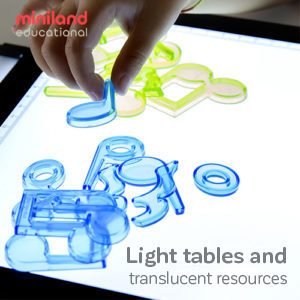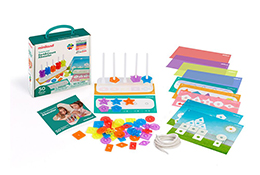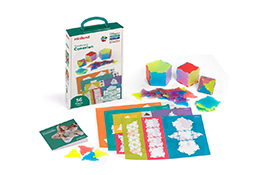One of our Guest Educators this month is SEL Expert Kim Gameroz, who runs the highly successful channel @SELebrategoodtimes. For the past 15 years, Kim has coached, trained, and mentored teachers, students, and families around the globe who want to revolutionize classrooms by taking on a systematic approach to teaching social and emotional skills.
As part of our You Belong initiative, Kim has selected her Top Miniland Picks to support your inclusivity efforts in the classroom and shares why these are her favorite Miniland SEL tools:
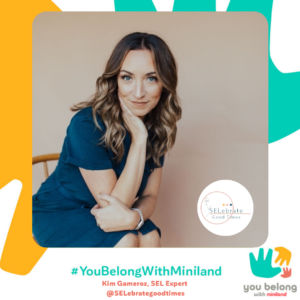
As educators, it’s important that we start building our students’ emotional intelligence, self-awareness, and emotional regulation from day one. Emotiblocks are the perfect way to incorporate these skills throughout the school day.
Teachers can start their day by identifying how they feel using these blocks. By piecing the blocks together and matching their facial and body expressions, students are able to visualize how they too can match their feelings using these manipulatives. Have students take turns in small groups by taking apart and building a representation of how they feel during the day. I love that there are so many different options of skin tones, clothing, and facial expressions so our children are able to create something that they can truly identify with. Students can sit in a circle and discuss not only what pieces they chose, but why they chose each piece.
Emotiblocks are also the perfect tool to add to a Calm Space in the classroom. Students can build a model of how they are feeling while they are taking time for themselves in a quiet space to calm down and reset their brains and bodies before rejoining their classmates and the group plan. Teachers can support their students by connecting with them while they’re in the Calm Space or Zen Den, by getting down on their level, checking in with the tools or strategies the child has chosen to support themselves, and offering a hug or a high five for choosing tools that meet their needs.
And these conversations don’t just end there. The most important thing is that students have time to discuss what strategies or tools they might use to support themselves throughout the day no matter how they are feeling. Coming up with a classroom toolbox is the perfect visual to continuously support students of all ages, and is a skill that will last a lifetime.
Quick Tip: Use sentence frames such as:
“I chose this face because I feel ______ today.”
“The eyes/mouth/face I chose matches mine because ________.”
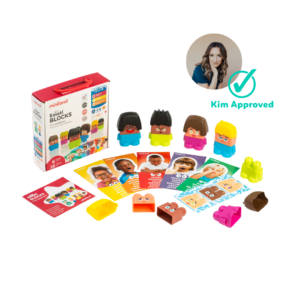
Are you looking for an interactive, fun, and engaging activity for your students that fosters communication, problem solving, and Social Emotional Learning? Miniland’s Emotions Detective is the perfect game for all of this and so much more.
Small groups can play this game during rotations as an activity or students can work through the Emotions Detective cards as an independent, or enrichment, activity after they complete their work.
In the classroom, students can take turns spinning the wheel, choosing the cards, and discussing what they would do to solve each social situation. If students are playing in a small group, they can take turns discussing what they think the characters should do. They can also make connections to the stories that they’ve read where these same situations have popped up in their picture books with their characters. They might also make connections to events that have happened in their lives or to real life situations that have occurred to them or the people that are in the world around them. These conversations are a great way to circle back in order to gather ideas for writing personal narratives, opinion pieces, as well as realistic fiction stories.
Quick Tip: Before having students work through the game on their own or in small groups, model how to play the game by incorporating it into your Morning Meeting.
Model your thinking out loud using sentence starters such as: “I have a connection. One time ______ happened to me before and I chose to ______. After I did that, the people around me felt _____.” You will also want to model how the characters on the cards feel before and after. Using the sentence frame: “I think he/she feels _____ because _____. Now they feel _____ because _______.”
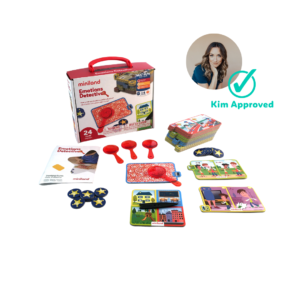
Mindful Kids is my go-to activity for brain breaks in the classroom. We can feel that energy rise and fall within our students throughout the school day, and pulling out this toy is the perfect way to help us manage our emotions and continue to co-regulate with the people around us.
Whether you want to energize your students because they’re feeling sluggish or running slow, or you want to calm them down, reboot, and reflect on the day, Mindful Kids is a great way for them to continue to be present in the moment and choose strategies that will support them.
Choose a template, spin, and guide your students in the poses. Instead of playing one more movie, and having students glued to yet another screen, this toy from Miniland not only engages our students, but empowers teachers and student leaders as they model and walk our students through their practice. Get ready for lots of laughs, deep breathing, and mind-body connections throughout the day. This toy is a must have in your classroom.
Quick Tip: Have students take turns choosing the template for the class. This can be the Student of the Day/Week, or individual students can work towards this as a special reward.
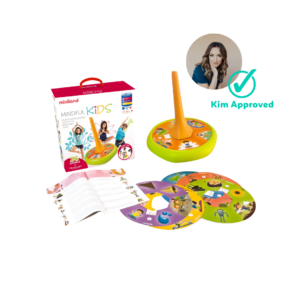
For more info on Kim and our You Belong initiative, head to our Instagram and Facebook pages!
Bio: Kim Gameroz, SEL Expert:
Kim Gameroz is a change agent for schools and districts who seek to revolutionize classrooms by taking on a systematic approach to teaching social and emotional skills. She previously served as the Social Emotional Learning and Behavior Support Teacher on Special Assignment in Orange County, California where she developed her District’s roadmap to support all students’ and teachers’ social and emotional competencies. For the past 15 years, Kim has coached, trained, and mentored teachers, students, and families around the globe. She was invited to speak at Social Thinking’s Global Provider’s Conference in San Francisco, as well as Get Your Teach On’s Rock Your School. She has also consulted for school districts and families in need of social and emotional support, served on SEL panels for the Cotsen Art of Teaching Foundation, and has appeared on various webinars and podcasts with leaders and companies near and far. She holds a Bachelors in Psychology from California State University, Long Beach, and a Master’s in Education from National University, San Diego. She currently resides in Dallas, Texas with her husband, Shaun, and son, Wyatt, and is looking forward to spreading her knowledge of SEL even further to schools, districts, and homes around the world.

